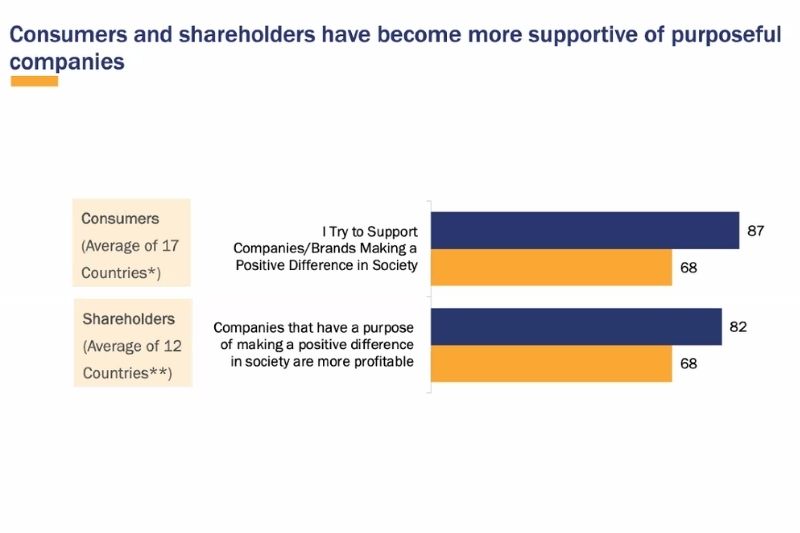A strong sustainability ethos can help your firm hit its financial targets. GlobeScan CEO Chris Coulter shares 4 sustainable business strategies to help you respond to evolving stakeholder expectations at Rethink 2020.
GlobeScan CEO Chris Coulter has over 15 years of experience in providing counsel to firms on all matters related to sustainability and leadership.
An insights and strategy firm specialising in conducting global deep-dives into understanding shifting consumer sentiments, GlobeScan capitalises on the extensive data collected and advises leadership organisations on achieving optimal corporate social responsibility by building effective engagement policies with stakeholders.
From an increased socio-environmental awareness to the dominance of conscious consumers wanting to only engage with socially-responsible corporations, Chris shared many such findings at the ReThink 2020 event, indicating the imminent need for companies to reconsider current practices.
Statistically speaking, companies that integrate sustainability into their operations and purpose are believed to perform better financially. As of 2020, 82% of shareholders believe companies with a vision for sustainability are more profitable – a sizeable increase of more than 10% than in 2016.
We’ve summarised key takeaways from his speech that firms will need to keep in mind to make great strides in sustainable strategy development and attain trusted leadership on all counts.

GlobeScan CEO Chris Coulter
1. Design ambitious CSR strategies
Chris advises setting big, bold corporate social responsibility goals to satisfy the evolving needs of stakeholders. “It’s that the way leadership has evolved now. There is a very limited appetite for incremental improvements. It requires big ambitions, goals that are very dramatic, and sometimes very difficult to achieve,” he asserts.
For example, Microsoft, disrupting the league of carbon-neutral initiatives, announced their climate negative strategy earlier this year. Chris recounts how this ambitious commitment to go above and beyond the carbon-neutral promise was vital in building expectations for the company and its leadership across spectrums. “Anything less than carbon neutral or a net-zero commitment from companies is met with a sense of disappointment among stakeholders.”
2. Position core strategy to achieve tangible results
The ongoing pandemic has resulted in an increased sense of urgency to resolve crises across all fronts – even those that have often been dismissed in the past. “In this tumultuous time, stakeholders and customers are very preoccupied with broad systemic change,” explains Chris. He also notes that there’s been an exponential growth in expectations for businesses, partly because of what they’ve done to respond in face of the pandemic. “The public is interested in what companies are doing in the socio-environmental realm. They want to know what is being done around sustainability.”
He suggests aligning firms’ core strategy to stakeholder expectations and centre policies around inducing a systemic change. These could be grand-scale commitments of going carbon neutral, or as simple as delivering quality products and treating employees equitably – just as long as customers see tangible results.
Unilever, Patagonia and IKEA were named as global leaders in integrating sustainability into their leadership. The common thread among the three? They were all able to define sustainability, in their own terms, in a brandable and scalable way. Be it Unilever’s 10-year sustainable living plan or IKEA’s People Planet Positive strategy, these corporates were instrumental in assuring stakeholders of their commitment to being a socially-responsible organisation.

3. Strategy is important, but so is storytelling
A key aspect to achieving sustainable leadership is to inspire those within your company’s ecosystem to buy into your purpose. Sustainable strategy development, while still covering key grounds like risk mitigation and materiality, has taken on a pathos-driven approach to involve stakeholders and consumers alike in the company’s ESG strategies.
Moving away from the technical aspects of strategy outline, sustainability leaders choose to weave a story around their mission statement, focusing instead on the big picture. This, as Chris suggests, helps them cut through the noise. “Tell that story in ways that are compelling, clear, and understandable. Without that story, without that sense of recognition for leadership, you lose the virtuous cycle of reaping the rewards of sustainability and then, the increased appetite for more within your company.”
Leaders need to publicly and continually voice their support on issues relating to sustainability. “An important attribute that is present among all the reputed sustainable leaders is that they are engaged, committed and passionate about sustainability. They speak about it frequently to investors, to customers, to employees on a consistent basis,” says Chris.
4. Design contributions unique to your firm
With more and more companies jumping aboard the corporate social responsibility bandwagon, no matter how well-intentioned your purpose, it is bound to go unnoticed amidst the inundation of initiatives that today’s woke customers are faced with. Chris suggests the way to go about this is to focus on developing a unique contribution, distinctive to your firm and its values.
“It’s important to not only fulfil all of the expected table stakes on sustainability leadership – reporting, disclosure, materiality, and having a clear management system to address all the fundamentals of sustainability. You also need to find a way to define your unique contribution,” he reminds us.
The mark of a sustainable leader lies in their ability to find a distinctive and special contribution that goes above and beyond the norm. “In climate change, for example, choosing carbon neutral pathways, joining TCFD reporting, and disclosing through the Carbon Disclosure Project are considered fundamental,” he states. “Then, you need to consider what your company can do that acts as a catalytic and brings you into a place of indispensability – where people look to you and say, wow, we really do need that organisation because, without them, we would miss this piece of the puzzle,” states Chris.

Wrapping Up
As circumstances change and perceptions evolve, new definitions of leadership have emerged over the decades. We have successfully transitioned from the harm reduction era to focusing on strategic integration and then to the current purpose-driven era. Industry watchers predict a more technical trend of regenerative corporate leadership to be on the horizon – one that will compel the sector economy and its leaders to take quantitative steps towards meeting the Paris Agreement targets at a more rapid rate.
Related Articles
Christina Dean: The Woman Leading a Global Movement in Fashion Sustainability
K11 Musea: Is This USD 2.6 Billion Sustainability Mall Worth the Hype?
Chris Brown: Rethinking Corporate Sustainability in Hong Kong





